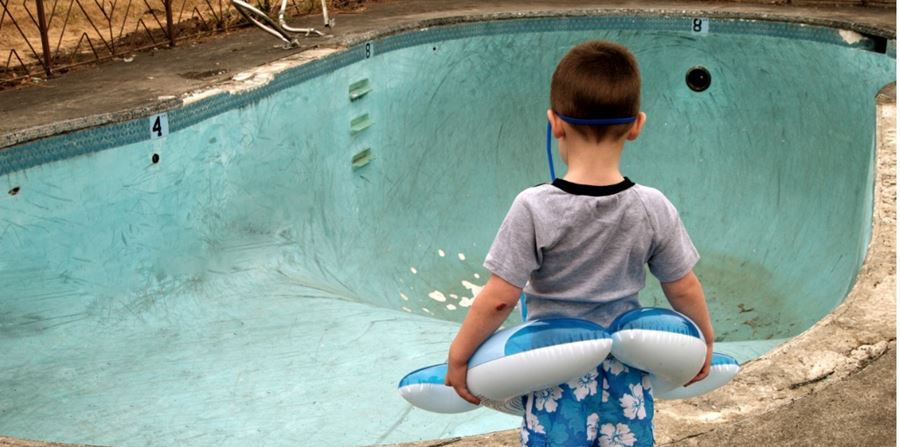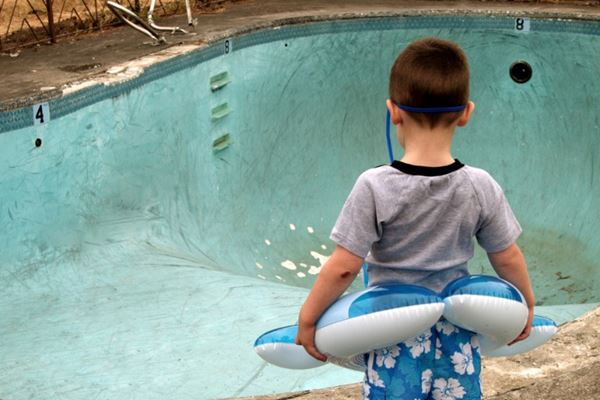Floating Swimming Pools: Part II

This is the second blog of a two-part series on the common factors that can impact a pool enough and cause it to pop or float. Read part one in the series.
Spring is here, which means summer is right around the corner, bringing with it warmer weather. As pools begin to open up, this article can serve as a reminder for a common, yet sometimes mysterious claim—floating pools.
When you read the title you probably wondered how a swimming pool can float. Or perhaps you thought it was another fancy pool like an infinity pool. Nope. Sorry. Swimming pools can actually float, and it is not a good thing when it happens! Insurance professionals who have been faced with a claim arising from a floating pool may be wondering if there is coverage for such a loss.
First and foremost, if you want a little background on how this happens, check out the first blog in the series here.
For pool owners, unfortunate things can happen from time to time, which can temporarily raise the groundwater level in the ground surrounding a pool. If there is not enough water in the pool, and more water around the pool, it can cause the pool to "pop," and you have a major issue.
Common Factors That Cause a Pool to Pop
So what are the common factors that can impact the groundwater level around a pool enough and cause it to pop, or float?
- A major change in the surrounding terrain. Development of the land around a property that has existed for many years can alter the groundwater level, although most commonly it causes the level to drop deeper into the ground.
- Changes to the property immediately surrounding the pool. For example, if the backyard in which the pool is located has landscaping changes that redirect surface water (rain, snowmelt) towards the pool then that increased surface water flow can seep around the pool causing a significant change in the level of water in the ground around the pool.
- Excess or abnormal rainfall. In extreme weather events, surface water that would normally drain away can collect in the soil around the outside of a pool. This is particularly troublesome in cold climates where excessive rainfall occurs in the winter. In that case, the ground generally is frozen but the ground adjacent to the pool is either not frozen or is of greater permeability due to the fact that the pool was backfilled with well-draining soil.
- Failure of the hydrostatic valve. Concrete pools are generally installed with a hydrostatic valve located at the deepest part of the pool. It is a one-way valve that will open when there is greater hydrostatic (water) pressure under the pool and it will allow the groundwater to flow into the pool. Its sole purpose is to reduce the chance of the pool floating when the water level in the pool is lowered or emptied for cleaning or maintenance. Sometimes, however, the valves stick closed resulting in the pool floating in the presence of a hydrostatic pressure imbalance (with the pressure under the pool greater than the pressure exerted by the weight of the pool and the water within it).
- Lowering the water level in the pool. While this does not change the groundwater level around the pool, it is the relative balance between the two that is important. In some cases, if a pool is installed when the groundwater level is lower than normal (say after a drought), and the pool is filled with water with a subsequent (and undetected) increase in the groundwater level at some time in the future, if the pool is ever emptied of water or to a point below the higher groundwater level, the pool will float unless it has a properly operating hydrostatic valve.
You may be wondering why hydrostatic valves are not installed into fibreglass pools. They can be but it is difficult to make sure that they are properly backfilled, owing to the fact that a fibreglass pool is set into an excavation and the hydrostatic valve is best located at the lowest point of a pool. Instead, fibreglass pool installers often will create a sump beside the pool with a cover that looks like a skimmer cover. If the water level in the pool needs to be lowered the sump can be checked to make sure that the groundwater level is below the desired water level in the pool. If it is not, then the water level in the ground around the pool must first be lowered (not an easy thing to do in a fully landscaped backyard).
Damages Associated with a Popped Pool
So what type of damage can be expected if a pool has been floated? Well, as with many things in life it depends on a lot of factors. Firstly, is it a concrete pool or a fibreglass pool? A concrete pool will need to be demolished (unless the insured is willing to have an off-kilter pool) which is expensive. Then the pool and the surrounding landscaping that needed to be removed to allow for the demolition and reconstruction of the pool will need to be reinstated. You would be looking at hundreds of thousands of dollars.
On the other hand, fibreglass pools can be lifted, the ground below adjusted to properly fit the pool again, and then the pool can be lowered back into place and the surrounding landscaping reinstated. In such cases, the cost would more likely be in the $50,000 to $100,000 range.
Things to Consider When Assessing a Claim for a Floating Pool
The following list includes many of the factors that should be considered if you are assessing a claim for damages associated with a pool that has popped out of the ground:
- If the pool was concrete, was there a hydrostatic valve? If not, this could be a design fault unless there was some other provision to deal with hydrostatic pressure.
- If there was a hydrostatic valve, was it plugged? It may need to be retained for a more detailed forensic analysis. It should be noted, however, that these valves are known to get jammed with dirt and debris.
- If the pool was under construction (and thus empty), what steps did the contractor take to ensure the pool would not float? Was the groundwater level confirmed? Were there any other possible construction-related issues that could have increased the water level in the ground around the pool? These factors can be helpful in determining if there was a construction issue and possible opportunities for subrogation.
- Was there any extraordinary rainfall or snowmelt possibly combined with the frozen ground?
- Were there any changes to the landscaping on the property immediately surrounding the pool that could have directed surface water flow towards the pool?
- Were there any changes made to the property outside of the insured's property that could have directed water towards the insured's property? For example, if a large field that would have easily absorbed rainwater is subsequently converted into a parking lot with inadequate drainage consideration (e.g.surface water flows towards the insured's property). Or maybe a neighbour added a pool to their yard and caused drainage from their backyard to flow into the insured's backyard. These possibilities could also lead to a viable subrogation avenue.
Having a pool may be a nice luxury, but it can cause devastation when the owner looks outside and finds the walls have popped. Lots of questions may run through the minds of owners or insurers, and many times, those thoughts may surround pool installation. But, there are a lot of things to consider. Did the groundwater level change? Has the owner lowered the water level in the pool substantially? Has there been substantial rainfall? It isn't all black and white, which is why opting to use an expert may be necessary.
Our experts are ready to help.


